| 1 | The USA’s most common snake |
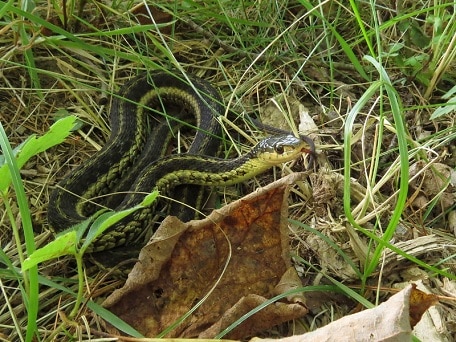
Compare to the drizzly dampness of the UK, the USA encompasses almost every habitat imaginable. There’s humid everglades in Florida, wide open farmland in Ohio, and there’s snowy peaks in Colorado which could leave you stranded in a hotel for several months. Despite this huge variety, there’s one snake that manages to live in every lower 48 state except Arizona – the common garter snake.
While nobody has counted this species by hand, the common garter snake is widely believed to have the highest headcount of any US snake. Its range stretches from the sunny outskirts of Miami to the frosty northwest territories of Canada. It’s well at home on the east coast, comfortable in California, and has powerful colonies in the Rockies. The only habitats they dislike are deserts, which is why they’re absent from Arizona.
The second most common member in the USA is the terrestrial garter snake, which inhabits an impressive 14 states (mostly in the western half), but even this falls well short of the common garter snake’s 47. There’s even a slight possibility they inhabit Alaska, which would bring the total to 48.
Generally, common garter snakes prefer grassy locations with a water source nearby, such as streams or ponds, but forests, steep hills, farms and marshland are also acceptable. There are 13 subspecies, each under the united common garter snake umbrella.
| 2 | Max length: 134cm |
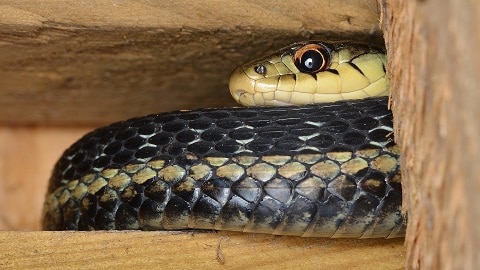
The common garter snake isn’t the most massive snake, but there’s a wide variety in length, from 46cm to 134cm as adults. Its pupils are perfectly round and black, rather than vertical and crocodilian. Its colours vary wildly, but the tell-tale feature is 3 thin stripes – one down the centre of their back and another on each side.
This snake lacks any blotchy marks like a boa constrictor, or wraparound, scarf-style stripes like a cobra. The thin stripes make up most of the patterns, but the olive-grey areas between them sometimes have subtle black patches as well.
For instance, the eastern garter snake is the most common subspecies of all, ranging from Florida to Ontario. Its base scales are a grey to olive-green, and the stripes and belly are a creamy yellow. The Texas garter snake can be wildly different, with a black and orange colour. There’s massive variety across the 13 subspecies, but the 3 body-length stripes are the constant giveaway.
| 3 | Diet: frogs and small grubs |
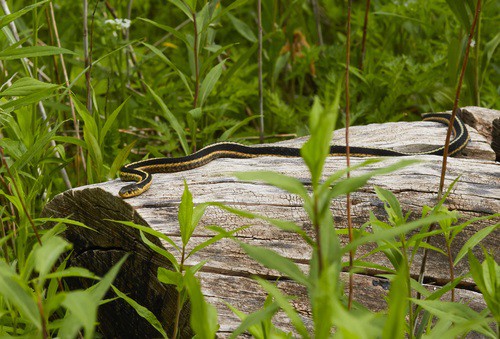
The common garter snake is a day-faring (diurnal) species, and moves at a fast and nimble speed for such a small size. They’re skilful climbers, and often ascend into shrubs, with the goal of finding their main dietary sustenance: slugs, leeches, earthworms, and crunchy snails. Unlike corn snakes, common garter snakes eat very few rodents, although they do accept them in captivity. They also eat amphibians from ponds, even fish, but it’s all about small slimy creatures with this snake.
Consequently, the common garter snake is a boon to American gardeners everywhere, even if they’re oblivious. Most gardening websites recommend leaving this snake be, as it’s the perfect way to prevent annoying nibble marks on crops, without raising a finger.
The common garter snake relies on active pursuit rather than lazy ambush. It lacks venomous teeth, but it does have venomous saliva, which is more than enough to put a slug to sleep. If you’re an avid gardener who’s convinced that all the slugs have disappeared, then your garden may have a new slithery resident.
| 4 | Resistant to newt toxins |
In nature, one of the most destructive toxins that tears a path through any organism it enters is the tetrodotoxin. This is an extremely powerful neurotoxin, and in the novel of From Russia With Love, this is the toxin that Rosa Klebb stabbed James Bond with using the spiked end of her shoe (unlike the film, where he managed to dodge). It’s why Japanese fugu has to be thoroughly prepared and it’s why amateurish versions can cause a tingling sensation.
Another source of tetrodotoxin is the rough-skinned newt of America. This orange amphibian is able to walk through heavy snake territory untouched, as its body is so poisonous that most snakes would roll over and die after eating it. Many snakes don’t bother to hunt them, having evolved to associate its appearance with death.
But there’s one snake family which breaks these rules. Along with the Santa Cruz garter snake and aquatic garter snake, the common garter snake has evolved resistance to this newt toxin, and can eat them without dying. The only visible symptoms they suffer are lying still or slowing down for a while.
| 5 | Why garter snakes are winning |
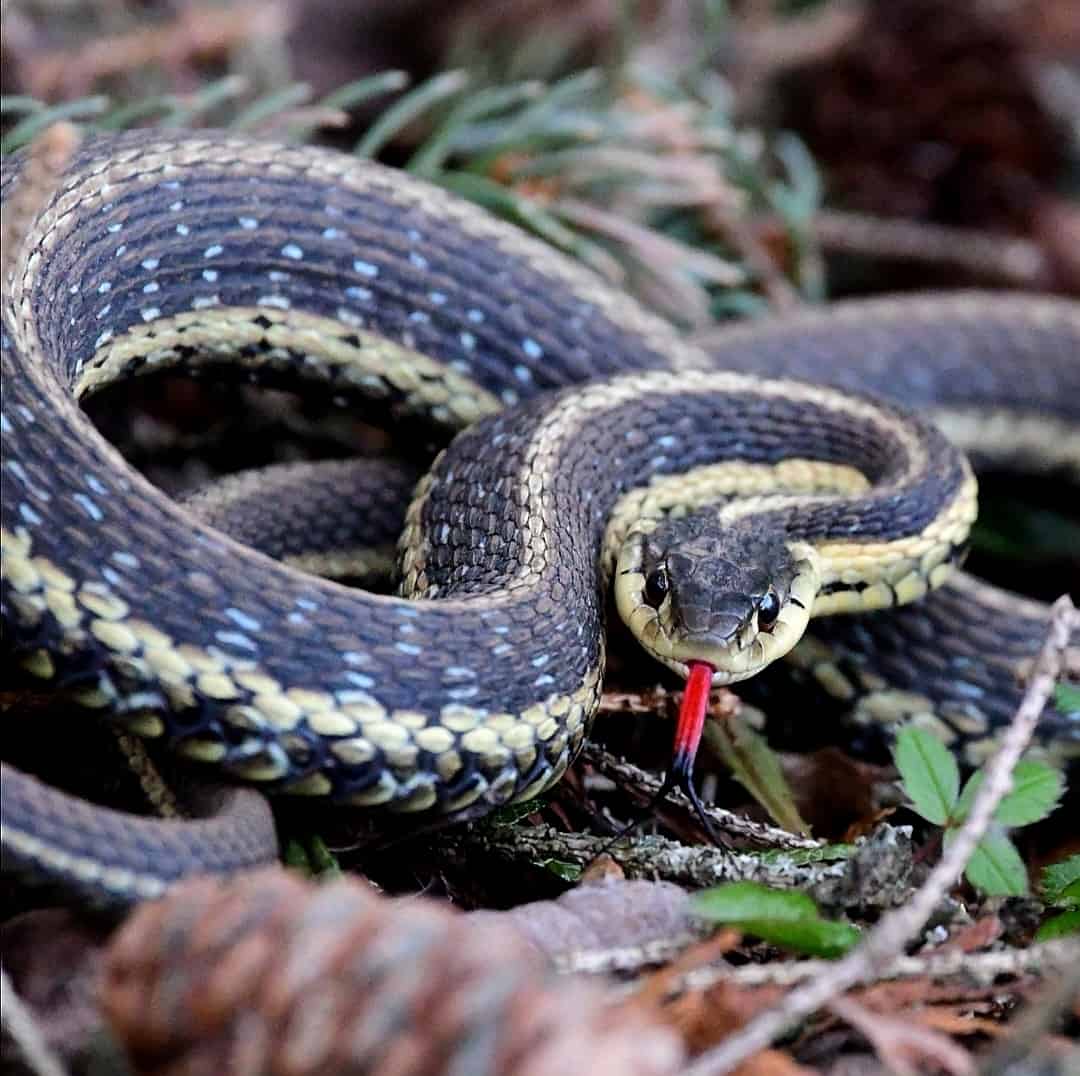
It turns out that garter snakes and great-skinned newts have been locked in an arms race for thousands of generations, with no hope for peace between the warring species. Biologists have found that in areas where the newt is barely present, the garter snakes have no resistance to tetrodotoxin. Similarly, the newt subpopulations on Vancouver Island have unusually low tetrodotoxins, and the snakes there are also missing the resistant genes. But in the San Francisco bay area, the local newts have thousands of times more tetrodotoxin, and the local snakes have a mirror image of higher resistance.
The common garter snake is winning the war, as its own adaption relies on changing the shape of sodium ion channels into cells, which the tetrodotoxins bind to. This change is very simple to keep replicating. The newt’s adaption, meanwhile, is to continually produce more and more toxins, which is far less sustainable biologically.
Garter snakes can even store newt toxins in their livers after eating them. This gives them their own defences for 1-2 months, meaning that predators who eat them (like the king snake and milk snake) suffer serious illness or death.
| 6 | Capable of forming friendships |
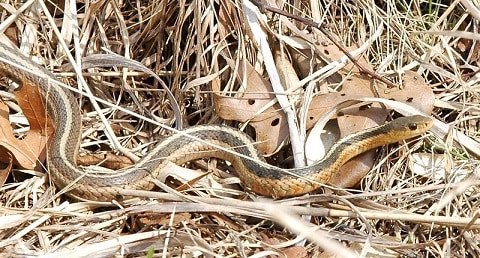
No snake is truly social, as the greatest communal activity tends to be an opportunistic huddling in a ball to conserve heat and moisture. Garter snakes, however, are proven to recognise fellow members of their species.
Scientists gathered 40 eastern common garter snakes, 30 wild and 10 captive. 10 at a time were dropped into a 3 by 3 foot enclosure with 4 tiny boxes inside. This meant that the snakes were forced to shelter with other snakes if they wanted the safety of the boxes. With each snake pinpointed by a dot on their heads, the scientists removed the snakes, scrambled them around, and dropped them back in.
Amazingly, the snakes returned to their previous box-buddies, changing position to form the same cliques as before. That wasn’t all, as the researchers identified “bold” and “shy” personality types within the snakes. The bold garters took time to slither around and explore new areas, while the shy garters were happy to stay put. The snakes tended to group together based on personality types as well.
| 7 | How males deceive each other |
Life is difficult for a male common garter snake. They outnumber females significantly, and it’s always a quick-thinking, rapid-reacting race to be able to mate with one. Male garter snakes awaken from hibernation significantly earlier, with the goal of waiting patiently for the slightest hint of female pheromones in the air. When a female finally arrives, the local males swarm her all at once, burying her beneath up to ten snakes.
Males attract females by producing pheromones with their skin, but every so often, a chosen one will appear which produces both female and male pheromones. These deceivers have a cunning plan, as they deliberately emit the female pheromones to lure all the nearby male snakes towards them. The males arrive in a mad dash, only to find no female.
Meanwhile, the supersnake will check that his deception is working, and slither at high (but silent) speeds back to the sexual spot where he first detected real female pheromones. Afterwards, he will mate with every female in the vicinity. It’s been proven that double pheromone garter snakes have a significantly higher reproductive rate.
| 8 | Don’t pick them up! |
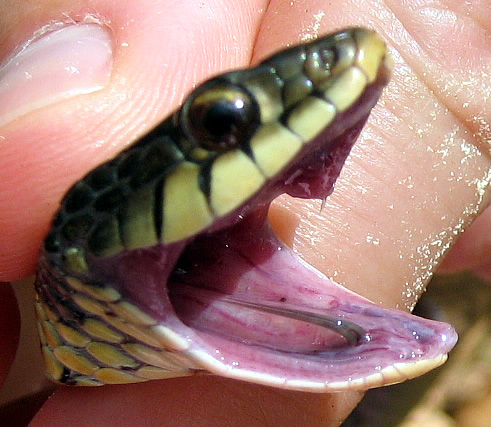
Garter snakes produce 18 to 40 newborns, a higher number than all rattlesnake species. The babies pop out as live young, encased in a gelatinous sac rather than as eggs. Mother snakes will bite and defend these sacs with ferocity, and the species is moderately aggressive as a whole, particularly when picked up. Nobody on record has ever been killed by a common garter snake, but with their mildly venomous saliva, several wounds have become hot, infected, and sizzling with pain.
The common garter snake has a huge variety of responses when confronted. In warmer weather, they’re more likely to flee, but in colder times, they tend to stand their ground or launch a savage attack. They’re also more likely to attack if they’ve just eaten a meal, unless they’re so stuffed with slugs they can barely move.
Older garter snakes tend to be more aggressive and cunning. Their endurance also rises; the youngest garter snakes can only exert themselves at full throttle for 3-5 minutes, but as they grow, this rises to 20-25 minutes.
| 9 | The Alaskan mystery |
Officially, the last fingers of common garter snake range fizzle out in British Columbia, held back by the punishing cold weather. But in 2005, a discovery changed everyone’s perceptions. It was a freshly killed garter snake, lying dead on a road in Haines, Alaska. It was obviously roadkill, but what was it doing that far north?
The authorities had several theories: 1) that it was a remnant, almost extinct population, 2) that it was an artificial introduction, perhaps an escaped pet, or 3) that garter snakes were travelling northwards and finally colonising one of the last empty states. Even to this day, the status of common garter snakes hasn’t been confirmed in Alaska, and whispers of their presence constantly circulate.
Another sighting happened in 2014, in Kasilof, southern Alaska. A man was in his backyard when a 45cm common garter snake fell from the sky and struck him, he claimed. In 1976, a local Mr Hodge reported sightings along the Taku and Stikine rivers. Conveniently, one of the snakes was lost after being stored in the State Museum in Juneau.
| 10 | Origin of the name |
The common garter snake might be common, but the flipside is that they’re expendable, with a short lifespan. The average member dies only in its second year, with the maximum wild lifespan theorised to be 15 years. A captive specimen lived for 20 years once, but the forest cobra’s record is 35 years. Part of the problem is that they’re prey for many bird species.
Although the common garter snake climbs shrubs to search for slugs, they’re mostly a ground-dwelling snake. When hibernating, their lairs are standard snake fare: mammal burrows, tree stumps, and natural rock cavities. Another special feature is their fast reactions, which make catching tadpoles in ponds a breeze.
People have long wondered about the garter snake’s name, and the answer lies with the stripes, which resemble the garters worn by men in the 1700s to hold up their socks. However, an alternative theory is that garter is a twisted version of “garten”, the German word for garden, their classic hideout.
